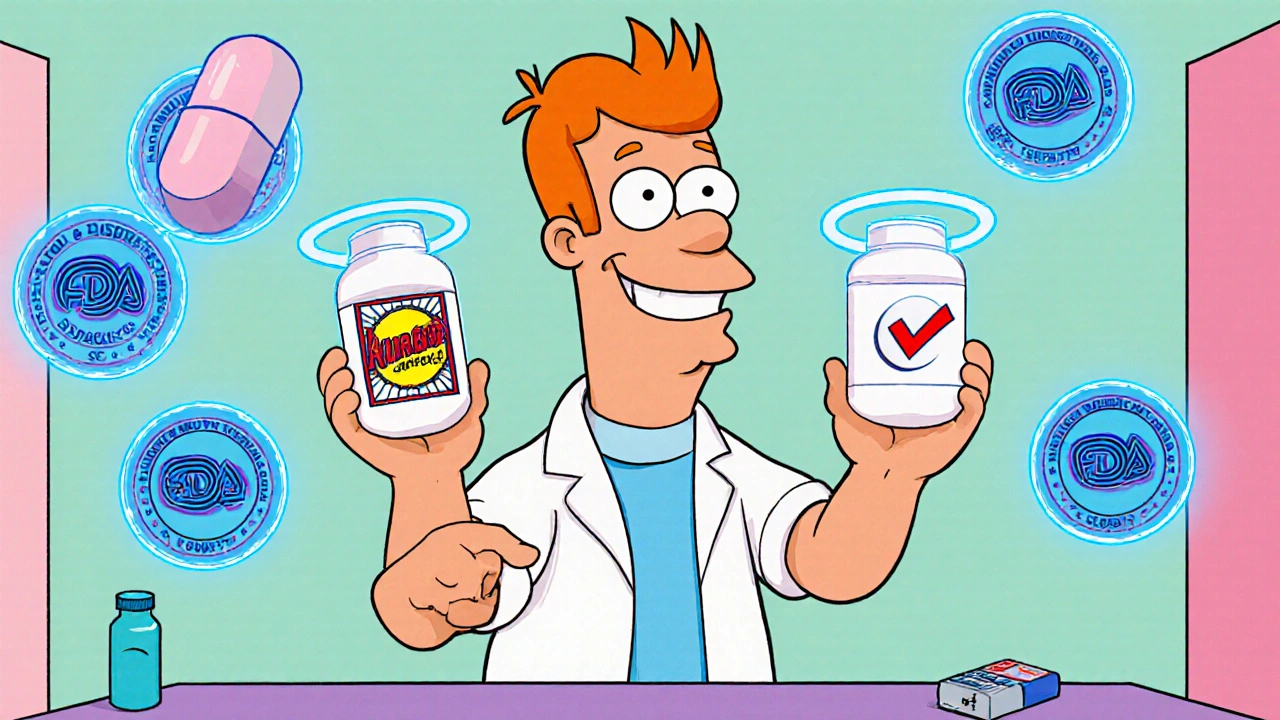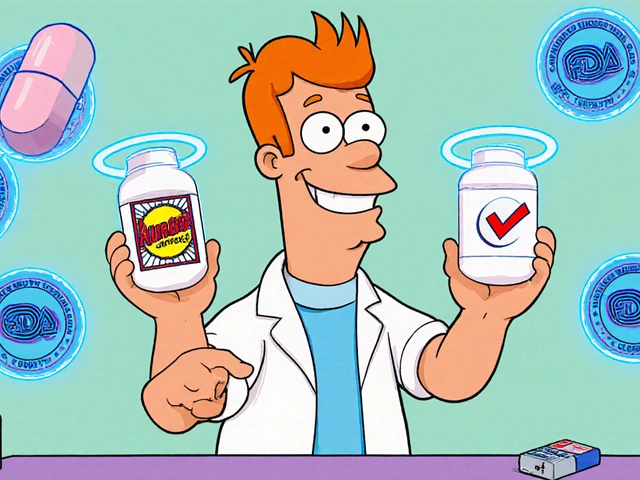Are authorized generics really the same as brand-name drugs?
When you pick up a prescription, you might see two pills that look completely different-one with a fancy logo, another plain and white. The price tag on the plain one is half as much. You might wonder: is this cheaper version just as good? The short answer is yes-if it’s an authorized generic.
Authorized generics aren’t just "similar" to brand-name drugs. They’re the exact same medicine, made in the same factory, with the same ingredients, by the same company. The only difference? No brand name on the label.
Think of it like buying a soda. The store brand version might say "Cola" on the can, but if it’s made by Coca-Cola in the same plant with the same recipe, it’s not a different drink. That’s what an authorized generic is. And the FDA says so.
How the FDA defines authorized generics
The U.S. Food and Drug Administration (FDA) doesn’t treat authorized generics as generics at all. They call them "approved brand name drugs that are marketed without the brand name on its label." That’s it. No extra testing. No different formula. No changes in how the drug works.
Here’s how it works: when a brand-name drug’s patent expires, the original manufacturer can start selling the exact same pill under a different label. It’s still made under the original New Drug Application (NDA), not the Abbreviated New Drug Application (ANDA) that traditional generics use. That’s why authorized generics don’t show up in the FDA’s Orange Book-they’re not listed as generics because they’re not generics. They’re the brand product, just unlabeled.
That’s a big deal. Traditional generics have to prove they’re "bioequivalent"-meaning they release the same amount of medicine into your body at the same rate as the brand. They have to pass strict tests on absorption and blood levels. Authorized generics skip all that. Why? Because they’re the same pill. No need to prove it again.
Why authorized generics are identical in every way
Let’s break down what’s inside the pill. Active ingredient? Identical. Inactive ingredients? Identical. Shape, size, coating, dissolution rate? All the same. Even the manufacturing equipment and batch records are unchanged.
Traditional generics sometimes swap out inactive ingredients-like dyes, fillers, or binders-because they’re not required to match the brand exactly. That’s why some people report different side effects or tolerability with certain generics. Maybe the pill dissolves a little slower. Maybe the coating irritates your stomach. Not with authorized generics. They don’t change a single component.
Factories that make authorized generics go through the same FDA inspections as the brand-name ones. Same quality control. Same audits. Same standards. The FDA doesn’t treat them differently because they’re not different.
One study tracked 5,234 patients who switched from brand-name drugs to generics. Of those, nearly 94% switched to some kind of generic. The researchers found no meaningful difference in hospital visits, emergency room trips, or how often people stopped taking their meds-whether they took a traditional generic or an authorized one. The only tiny bump? A slightly higher chance of ER visits with authorized generics, but the researchers called it "likely noise," not a real safety issue.

Real-world experiences: what patients say
People aren’t just trusting the science-they’re using these drugs every day and noticing the difference.
A survey by the Asthma and Allergy Foundation of America asked 1,245 people who switched from brand-name Singulair to its authorized generic. 87% said they noticed no change in effectiveness. Only 8% reported minor issues, and those were mostly about the pill’s appearance or how the inhaler felt in their hand-not how the medicine worked.
On GoodRx, users rated 37 different authorized generics an average of 4.6 out of 5. Ninety-two percent said they’d recommend them to a friend. Meanwhile, Kaiser Permanente tracked over 8,000 patients using authorized generics. Their adherence rates? 94%. For brand-name versions? 92%. No statistically significant difference.
And yet, confusion still exists. On Reddit’s r/pharmacy, users report pharmacists sometimes telling them, "This is a different drug," even though it’s the exact same thing. That’s not the fault of the medicine-it’s a communication gap. Pharmacists aren’t always trained to explain the difference between authorized and traditional generics.
Cost and insurance: how they stack up
Authorized generics cost less than brand-name drugs-usually 15% to 30% cheaper. But they’re often 10% to 20% more expensive than traditional generics. Why? Because they’re still made by the brand company, and they’re often sold through the same distribution channels.
Insurance companies usually put authorized generics in the same tier as traditional generics. That means your copay is the same. You’re not paying extra just because it’s the same drug with a different label.
Independent pharmacists know this. A 2022 survey found that 78% of them consider authorized generics interchangeable with the brand without needing a doctor’s approval. They’re treated like the real thing because, in practice, they are.
Why brand companies sell authorized generics
It seems odd: why would a drugmaker sell a cheaper version of their own product? The answer is business strategy.
When a patent expires, dozens of companies can make generic versions. Prices crash. Profits vanish. But if the brand company launches its own authorized generic, it can keep a chunk of the market. It’s not altruism-it’s competition. They’re undercutting other generic makers while still making money.
That’s why 68% of top-selling brand-name drugs launch an authorized generic within six months of patent expiration. It’s not a side project. It’s a calculated move. And it’s working. The U.S. market for authorized generics hit $18.7 billion in 2022, growing nearly 10% a year since 2018.

What’s changing in 2025
Recent rules have made authorized generics even more reliable. In 2022, the FDA clarified that these drugs must maintain the same lot tracking as brand-name products. That means if there’s a recall, you’ll know exactly which batch you got-and it’ll be handled the same way as the branded version.
The Inflation Reduction Act of 2022 also changed how Medicare Part D works. Seniors now pay less out of pocket for many drugs, and authorized generics often qualify for the lowest cost tiers. That’s pushing more people toward them.
Experts predict authorized generics will make up 15% to 18% of the global generics market by 2027. That’s not a flash in the pan. It’s a steady shift toward transparency and value.
When to choose an authorized generic
If you’re on a brand-name drug and your doctor says you can switch, ask if there’s an authorized generic version. It’s especially helpful if:
- You’ve had bad reactions to other generics (maybe the fillers upset your stomach)
- You want to save money but don’t want to risk a different formulation
- You’re on a chronic medication and want consistency
Ask your pharmacist: "Is there an authorized generic for this?" They can check the NDA number. If it matches your brand, you’re getting the same thing.
Don’t assume all generics are the same. Authorized generics are the gold standard for equivalence. They’re the brand, without the brand name. And that’s a good thing.
Bottom line: no compromise in quality
There’s no hidden catch. No trade-off. No secret difference. Authorized generics are the brand-name drug, made the same way, with the same ingredients, under the same rules. The only thing that changes is the price-and your wallet.
Dr. Janet Woodcock, former head of the FDA’s drug division, put it simply: "Authorized generics are the brand product without the brand name on the label-they are identical in every way."
So if you’re looking for the same effect, same safety, same reliability-but at a lower cost-you’re not settling. You’re choosing wisely.



Suzan Wanjiru
November 20, 2025 AT 12:15Same pill. Same factory. Same results.
Kezia Katherine Lewis
November 21, 2025 AT 06:56Moreover, their market penetration correlates inversely with patient-reported adverse events attributable to excipient variability, reinforcing their role as a de facto gold standard in generic substitution.
Henrik Stacke
November 22, 2025 AT 12:56Manjistha Roy
November 23, 2025 AT 00:42Jennifer Skolney
November 24, 2025 AT 21:03JD Mette
November 26, 2025 AT 20:25Olanrewaju Jeph
November 27, 2025 AT 16:02Dalton Adams
November 29, 2025 AT 01:03